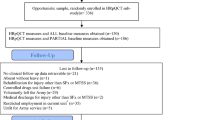Abstract
Summary
We investigated how cortical bone, trabecular bone, and muscle adapt in US Olympic Fencing Team members. These athletes demonstrate femoral cortical bone expansion, greater distal femoral trabecular bone density, and greater muscle mass compared to controls. This is the first study to investigate musculoskeletal adaptations in Olympic fencers.
Purpose
Wolff’s law states that bone remodels according to mechanical forces placed upon it. Our goal was to determine how cortical and trabecular bone adapt in Olympic athletes who perform intermittent high-impact activity.
Materials and methods
Nine males from the 2004 US Olympic Fencing Team and nine matched controls were evaluated by quantitative computed tomography. Femurs were scanned at 50% and 75% along the shaft. We evaluated cortical thickness (C.Th), cortical (C.Ar), trabecular (Tb.Ar), and total bone areas (Tot.Ar), proportions of C.Ar and Tb.Ar to Tot.Ar, cortical (C.BMD.), trabecular (Tb.MBD), and total bone densities (Tot.BMD), muscle (M.Ar), and thigh areas (Th.Ar).
Results
Fencers had greater C.Th (+24.5 to 38.8%), C.Ar (+16.9 to 19.6%), C.Ar/Tot.Ar (+6.3 to 16.3%), and lower Tb.Ar/Tot.Ar (−23.5% to −23.8%; p<0.05). Fencers demonstrated a positive difference in C.Th in the dominant vs. nondominant thigh at 50% (+5.4%, p = 0.040) and at 75% (+13.8%, p = 0.048 by analysis of covariance). Fencers had 54% greater Tb.BMD at 75% (p = 0.025), but not at 50% (p = 0.63). There was no difference between groups for C.BMD (p = .66 at 50%, p = 0.88 at 75%). Fencers had greater M.Ar (+30%) and asymmetrically greater M.Ar (+12.2%) in the dominant thigh (p < 0.004).
Conclusion
In world-class athletes who perform intermittent, high-impact activity, cortical bone expands, trabecular bone density is greater, and muscle mass is greater. This is the first study to examine musculoskeletal adaptations in Olympic fencers.



Similar content being viewed by others
References
Wolff J (1892) The Principle of Transformation of Bone. A. Hirschwald, Berlin
Fehling PC, Alekel L, Clasey J et al (1995) A comparison of bone mineral densities among female athletes in impact loading and active loading sports. Bone 17(3):205–210
Heinonen A, Oja P, Kannus P et al (1993) Bone mineral density of female athletes in different sports. Bone Miner 23:1–14
Egan E, Reilly T, Giacomoni M, Redmond et al (2006) Bone mineral density among female sports participants. Bone 38:227–233
Heinonen A, Oja P, Kannus P, Sievanen et al (1995) Bone mineral density of female athletes representing sports with different loading characteristics of the skeleton. Bone 17(3):197–203
Heinonen A, Sievanen H, Kyrolainen H et al (2001) Mineral mass, size, and estimated mechanical strength of triple jumpers’ lower limb. Bone. 29(3):279–285
Ward KA, Roberts SA, Adams JE, Mughal MZ (2005) Bone geometry and density in the skeleton of pre-pubertal gymnasts and school children. Bone 36:1012–1018
Gershon, S. (2004) U.S. Olympic fencing team coach, previous National Team fencing coach of the former Soviet Union. Personal communication
Nikander R, Sievanen H, Uusi-Rasi K et al (2006) Loading modalities and bone structures at nonweight-bearing upper extremity and weight-bearing lower extremity: a pQCT study of adult female athletes. Bone 39:886–89
Frost HM (1997) Indirect way to estimate peak joint loads in life and in skeletal remains (insights from a new paradigm). Anat Rec 248:475–483
Heinonen A, Mckay A, Whittal KP et al (2001) Muscle cross-sectional area is associated with specific site of bone in prepubertal girls: a quantitative magnetic resonance imaging study. Bone 29(4):388–392
Schonau E, Werhahn E, Schiedermaier U et al (1996) Influence of muscle strength on bone strength during childhood and adolescence. Horm Res 45(Suppl.1):63–66
Haapasalo H, Kannu P, Sievanen H et al (1994) Long-term unilateral loading and bone mineral density and content in female squash players. Calcif Tissue Int 54:249–255
Slemenda CW, Reister TK, Hui SL et al (1994) Influences on skeletal mineralization in children and adolescents: evidence for varying effects of skeletal mineralization in children and adolescents: evidence for varying effects of sexual maturation and physical activity. J Pediatr 125:201–207
Kannus P, Haapasalo H, Sankelo M et al (1995) Effect of starting age of physical activity on bone mass in the dominant arm of tennis and squash players. Ann Intern Med 123(1):27–31
Haapasalo H, Kannu P, Sievanen H et al (1994) Long-term unilateral loading and bone mineral density and content in female squash players. Calcif Tissue Int 54:249–255
Haapasalo H, Sievanen H, Kannus P et al (1996) Dimensions and estimated mechanical characteristics of the humerus after long-term tennis loading. J Bone Miner Res 11:864–872
Haapasalo H, Kontulainen S, Sievanen H et al (2000) Exercise-induced bone gain is due to enlargement in bone size without a change in volumetric bone density: a peripheral quantitative computed tomography study of the upper arms of male tennis players. Bone 27(3):351–357
NIH Consensus Development Panel on Osteoporosis Prevention, Diagnosis, and Therapy R (2001) Osteoporosis prevention, diagnosis and therapy. JAMA 285(6):785–795
Acknowledgements
The authors would like to thank volunteers and members of the 2004 U.S. Olympic Fencing Team for their participation in the study. They also thank Ramchand Deoki for assistance with CT scanning.
Funding
This work was supported by an internal research grant from the radiology department at our institution. The authors have no financial or commercial interests to disclose.
Conflicts of interest
None.
Author information
Authors and Affiliations
Corresponding author
Rights and permissions
About this article
Cite this article
Chang, G., Regatte, R.R. & Schweitzer, M.E. Olympic fencers: adaptations in cortical and trabecular bone determined by quantitative computed tomography. Osteoporos Int 20, 779–785 (2009). https://doi.org/10.1007/s00198-008-0730-z
Received:
Accepted:
Published:
Issue Date:
DOI: https://doi.org/10.1007/s00198-008-0730-z




